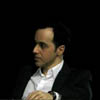 |
|
Illusory Reality (on “The Wall” series) “During one’s life there are modest events that can be a gift. I had just arrived at the hotel. With eyes of a blind man —always centered in this clear fog—I explored the indefinite room I was appointed to. Fumbling the slightly wrinkled walls and surrounding the furniture I found a big roundy pillar, so huge that my stretched arms were almost not enough to circle it. It was hard to connect my two hands. The pillar, massive and tall, rises till the top. Then I knew it was white. For a few seconds I knew this curious happiness that disclosed to Man things that are almost an archetype. (…) Certain fall, one of the Time Falls when the Shinto deities gathered in Izumoo (Japan, not for the first time) (…) one of the deities said: ‘We gave Man the succession, the day and night. The fishes and the rainbows. Now they had just created a weapon that finished History. Before it occurs we shall eliminate Man.’ The other deity answers: ‘This is true. But they also created something that fits a 17 syllable space. Let Man endures.’ Thus human race was saved by a haiku.” Jorge Luis Borges in Atlas, reports on worldwide travels. Photography not so many times has revealed in such potent way the ephemerality of the body and its ability to remain and to dissolute, through an image’s perspective. Many artists had explored questions that ranges from seeing the body as a repository of repressions, a manipulation and terror territories until a certain artificiality of the organic construction of the flesh. The body, exemplary holder of all constructive reasons which has impressed the mannerism of nowadays Photography, presents here as a protected subliminal memory object. It is before all a reference to the physical and sexual potency subjugated to a condition that clarifies the dynamics of the reunion and purity of its loss. Here there is no voyeurism but a vision frame, conditioned to morbidity and a certain fetishism. It is not at all about “morbid art”, like the English Damien Hirst or Mark Quinn. The non-expressionist state of these photos, however, is curious. Maybe they are closer to Cindy Shermann and Mapplethorpe. We know esthetical experience is different from real life (which has the weight of Life). Nevertheless, these photos from Roberto Schmitt-Prym proceed a determinate constructive friction between reality and truth. “Life truth” certainly is not the one our eyes can afford; it refuses to become a concept, and even tough it is contrary to its very own nature, we keep working to make it esthetical. This exhibition rejects the concept of the underlying reality— that one measured by the tendency to tragical myth and to the imminent mortality which we systematically reject. It constitutes images that just touch representation of the universe. It is not about a body mimesis but an explanation of it. The presence of these bodies is essentially outside them. Ironically we could say they had died a little. Schoppenhauer assumes human life is either pain or monotony, and as happiness does not last, life is surpassed by suffering. Man, that by his own nature sometimes rejects life, oscillates between permanency and ephemerality. Other times he is obligated to violate it. It is precisely due to this evidence that manifests that we are obliged to admit the reality of these photos. Its evidence shows the complex destination we give to our bodies and its unfoldments. The surface of these bodies get lost amongst the expressivity of its destruction that for getting lost on disappearance affirms their selves at their humanity condition.
|
 Gaudêncio
Fidelis, curador
Gaudêncio
Fidelis, curador